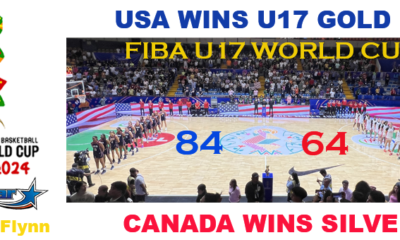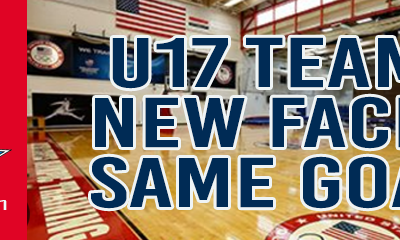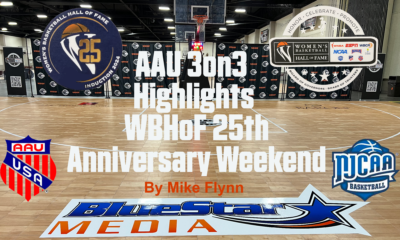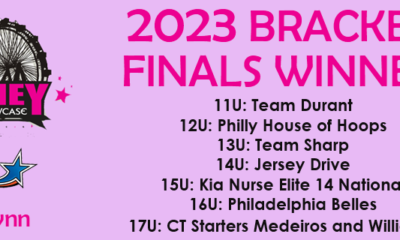
COLORADO SPRING – Last year the biggest question haunting all those Media types and evaluators watching the 2015 USA Basketball u16 trails was why wasn’t 6-2 mercurial player Rellah Boothe (Ocala, FL) selected to the team? It didn’t help that other selections, or lack of selections, were called into question and ultimately blame spread like a morning fog.
It was obvious by the time I got to watch the Brazil and Canadian teams in Puebla, Mexico for the FIBA Americas U16 Championships that Team USA was in trouble. I was concerned about the guard play, the lack of wing and inside scoring as well as the lack of athletic defense. Brazil won their game with the USA before playing Canada in the final and losing in OT by one. If you want, the games are on FIBA Americas website to review and, if you do, note the start of the Brazil game.
Since the USA doesn’t do silver, bronze or any other color award except gold, those players and coaches came back to the US to side views and looks the remainder of last summer. Where was the blame? What was the solution? There was a silent and mis guided move to blame the coaches, but they got the talent given to them. The players couldn’t be blamed as they were selected. In the end and most likely the first place to look was the selectors.
There were questions who they were, what was their experience, how many international youth female games they attended, how deep is their evaluation and team building experience and how were they selected and by whom? That’s a lot of questions but in the end it was about what was put out on the floor by the USA Developmental National Team selection committee. It was bronze.
When the 139 players lined up this past Thursday, Rellah Boothe was back and so were the 12 members of the 2015 FIBA Americas Bronze team. Same committee, same players, same challenge – put the best team together to defend their U17 World Championship. Everyone knew change was coming and it was only a matter of who and how many. There was a definite need for a healthy dose of Chemistry and Redemption.
After two days of drills and play at the USOTC that 139 was cut down to 101, then 73 and in turn, 41. It was obvious that the similar issues from 2015 trials of who to pick and why creeped into the selection process. This year it was obvious that there was more talent in the mix, more guard play and more post play along with bigger, physical wings. A year of maturity means a lot. I felt the best player on Friday was cut on Saturday. Impressive 6-2 big wing NaLyssa Smith (TX) along with two sound guards Kiana Williams (TX) and Jordan Nixon (NY) didn’t get the chance to take the floor after the second round of cuts. They could have made it to Sunday but no matter what – separation had to occur. Their elimination meant opportunity for others.
There are two levels of play in international basketball for the USA: Americas (16/18) and Worlds (17/19) You can make mistakes and win at the Americas and in turn fix the roster for the Worlds where the USA has recently depended on stars like Breanna Stewart (UConn-Storm), Diamond DeShields (Tennessee), Katie Lou Samuelson (UConn) and Asia Durr (Louisville) to tip the balance and grab gold. Until last year the Americas were a given. Sure the USA struggled against Canada for a bit in Mexico in 2013 but no one expected the Bronze last year. It’s important to recognize that it’s not just our failure but them catching up as well.
For those who closely follow youth basketball, it was also known that the 2016, 2017 and 2018 high school classes were not looking stellar in the potential array of talent that the USA could put out on the floor. The core issues – no star and no future Olympian-level guard inherently needed to lead a great team.
What the Committee did was select a final group of 41 players for the last day and the decision on who was going to play the point for this team and who the post and wings was still up for discussion. Along with 11 of the 12 members from 2015, there was a group of very big bigs plus strong and quick guards to manage through.
I had a hard time figuring out just who played best here in drills, who shot well and ultimately could fit with the other players until late Saturday. There was too much similar play, too many nuanced differences in each player’s game combined with athletic ability. The strong wings and athletic small forward types all have similar abilities. When you do evals for team selections you try to block them into groups and watch how they compete against each other during full court play. There were many such matchups where some failed and some impressed. By the next morning when the final 18 were listed, gone were nine members of the 2015 squad with only point guard Alexis Morris, wing Aquira DeCosta and post Sedona Prince left.
The guard line had so many options. Go big, go small, go quick, go experienced, go new. The two final 18 guards Destani Henderson (FL), and Abby Prohaska (OH) got here on intense play. The wings got stronger and more athletic with the addition of Maya Dodson (GA), Zoe Young (IA), Christyn Williams (AR) and stronger with Jenna Brown (GA0, Taylor Mikesell (OH) and Madison Williams (TX). With Brown and Mikesell the USA looks bigger and stronger out front like the International teams do.
The best and easy choices were the bigs: Charlie Collier (TX), Olivia Nelson-Ododa (GA), Sedona Prince (TX) and Janelle Bailey (NC). If you add Samatha Brunelle (VA) you have two big shooters in Brunelle and Collier and three very different but very effective posts in Prince, Bailey and the dynamic Nelson-Ododa. It was the play of these five that made the surprise high level move of Rellah Boothe, who was touted as “the” player needed for the USA u17s to win, being sent to the USA U18 Americas team not so shocking.
The deletion of Boothe means five players still have to be cut. Morris (TX), DeCosta (CA), Hillman (OH) and Boston (MA) could be in trouble because there is now enough roster talent to take their place, That last fifth cut will be the hardest.
This is now a team with guard chemistry, shooters and amazing athletic bigs who can score and rebound. The only deficit is being together for only a few weeks prior to Worlds competition which is why this U17 Team stayed longer for a cut to 12 and later training camp before departing for friendly games in France.
Happily, except for the early cut of Smith, the USA Developmental National Team committee gave head coach Dori Oldaker a great group to defend the gold in Zaragoza, Spain later this month. We may not have a star yet, but some way, somehow, someone will step up (maybe even two or three) and propel the USA to the gold.
NOTES: There are also five high school underclassmen selected to the USAB U18 Americas team to compete in Valdivia, Chile from July 19-23. Besides Boothe, making the roster are: Chennedy Carter (TX), Sidney Cooks (WI), Megan Walker (VA), and Evina Westbook (OR). It will be winter there and most of the event played during the NCAA D-I summer observation break which now allows college coaches to attend. There were initially 10 underclassmen at the U18 trials beside the four above and Boothe. Dana Evans (IN), Vivian Gray (TX), Anastasia Hayes (TN), Chasity Patterson (TX), LaDazhia Williams (FL) and Micaela Wilson (LA) were also on hand.
Mike Flynn is owner and operator of Blue Star Basketball and U.S. Junior Nationals. He is a National Evaluator and publishes the Blue Star Report which ranks the top 100 high school girls basketball players in the nation. He also serves as Secretary of the Middle Atlantic District AAU, National Chair for AAU Lacrosse, Consultant to Gatorade for girls basketball, member of the McDonald's All–American selection committee, & Consultant for Nike Global Basketball.









